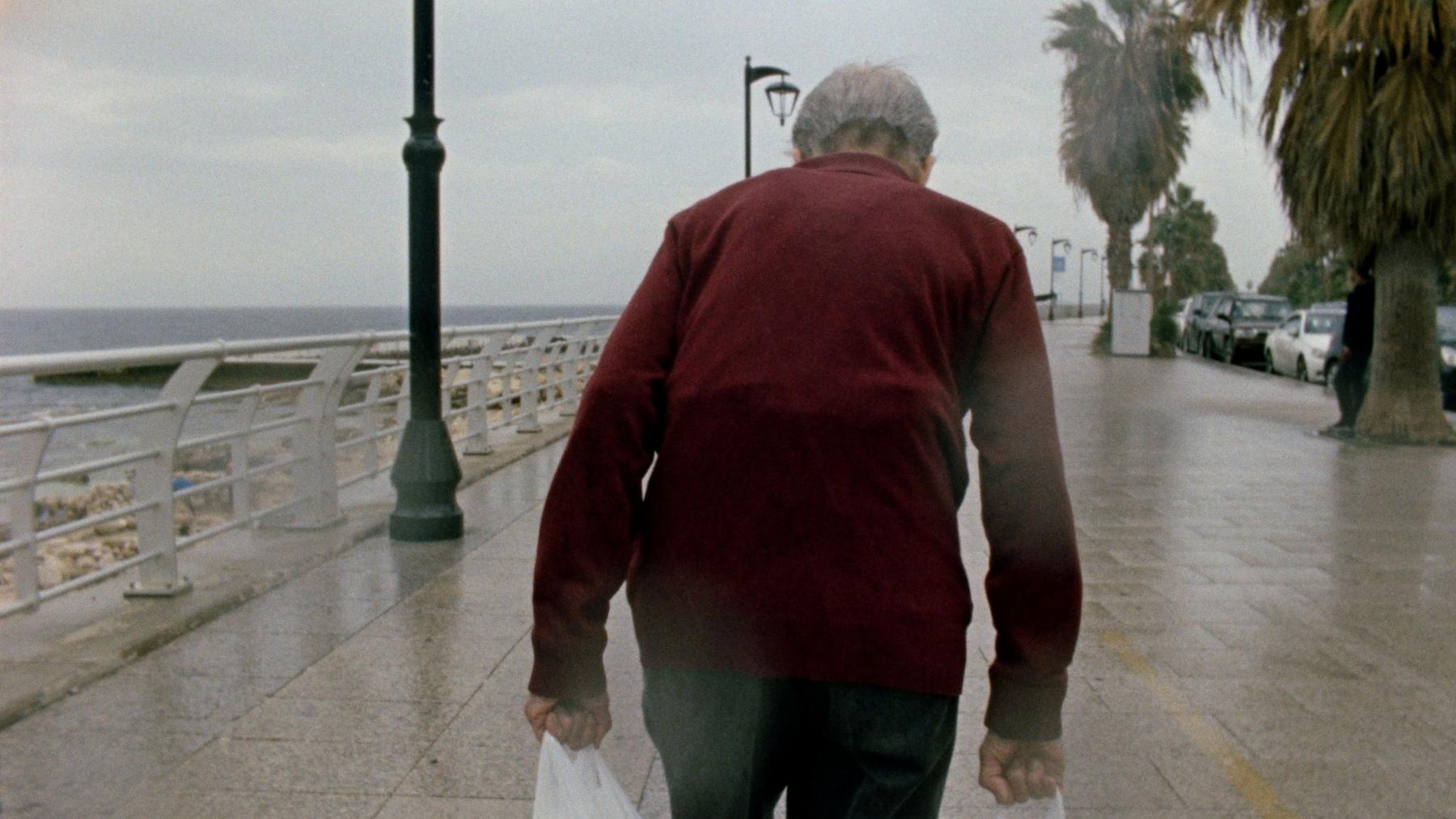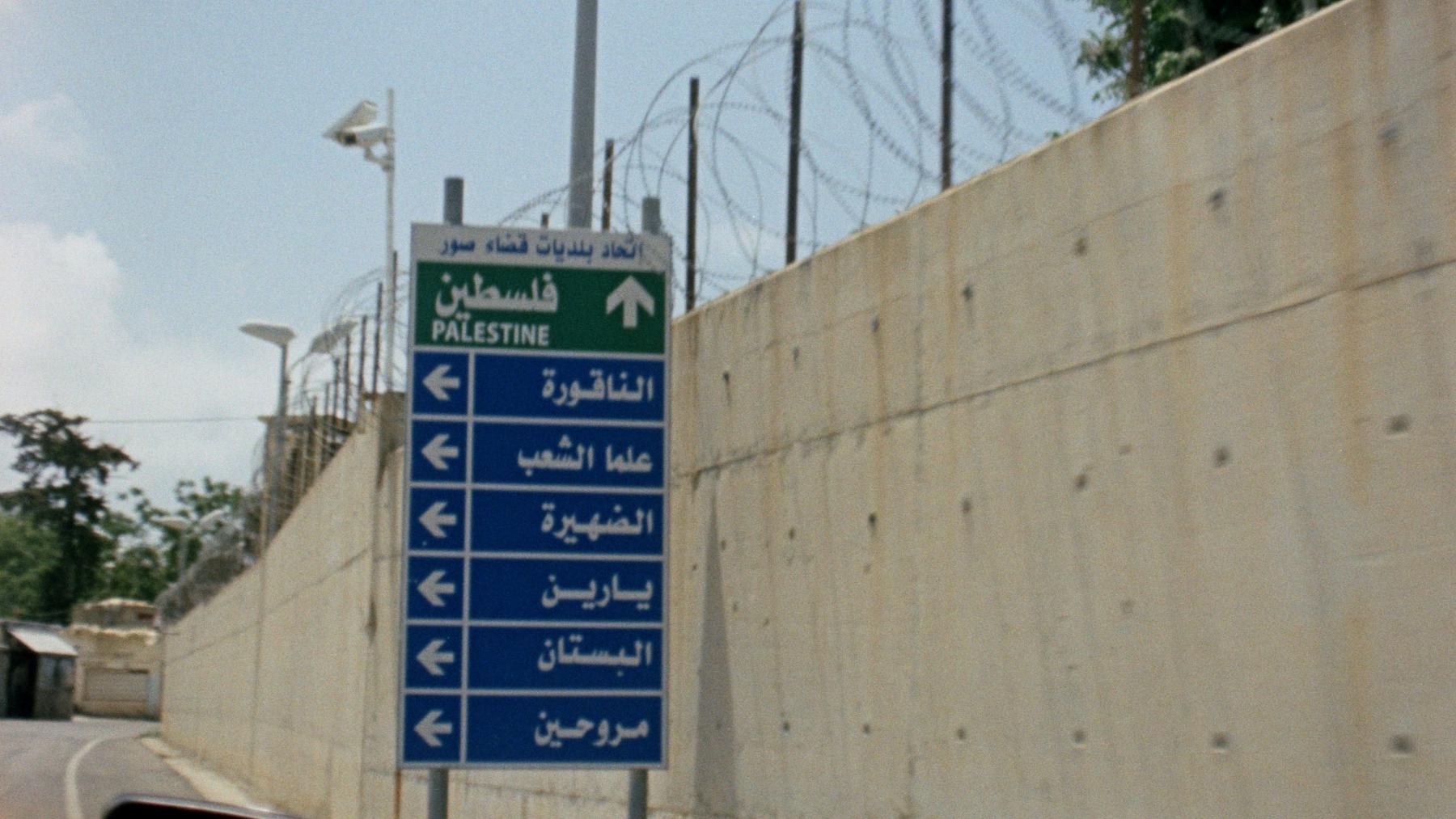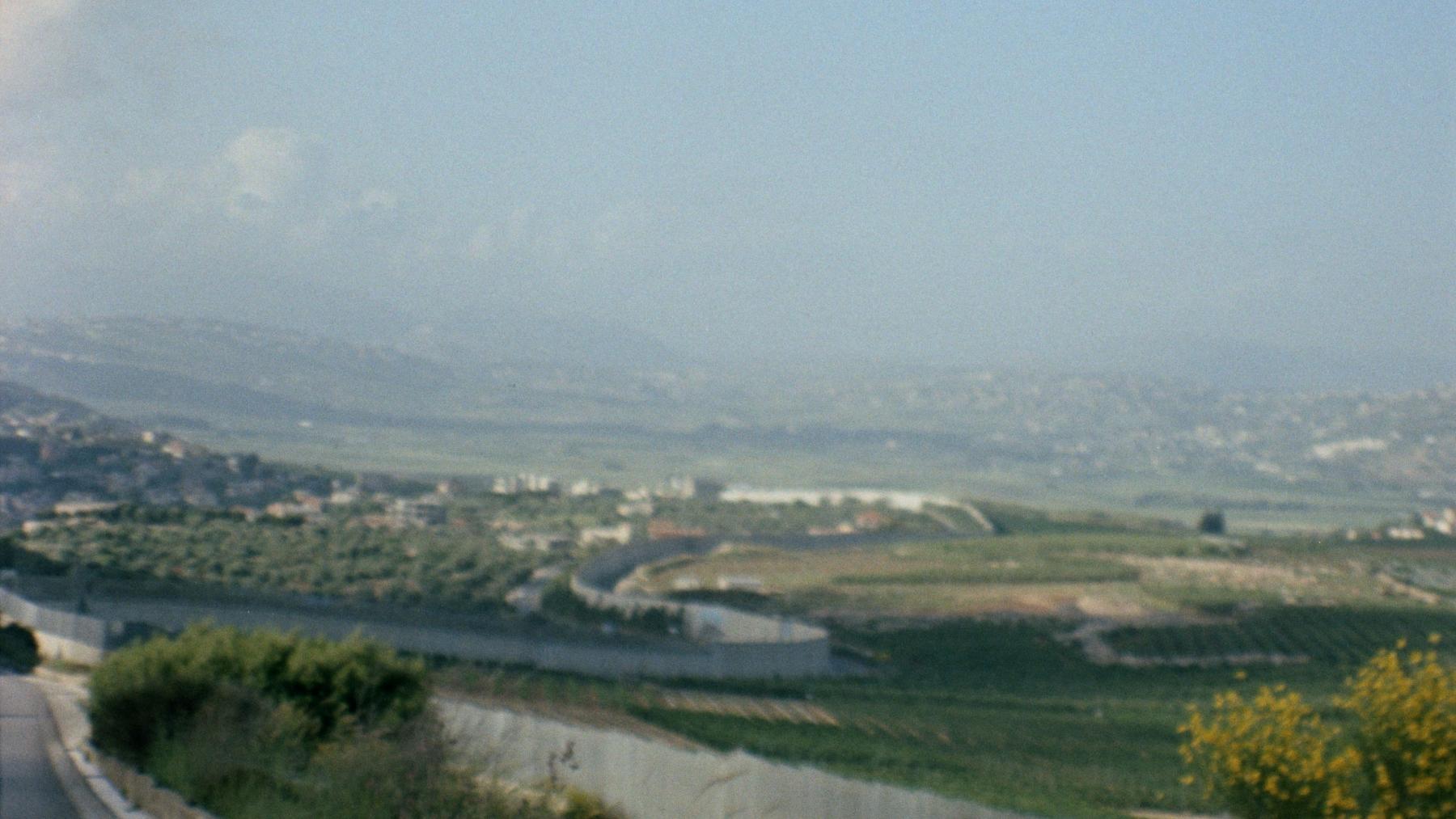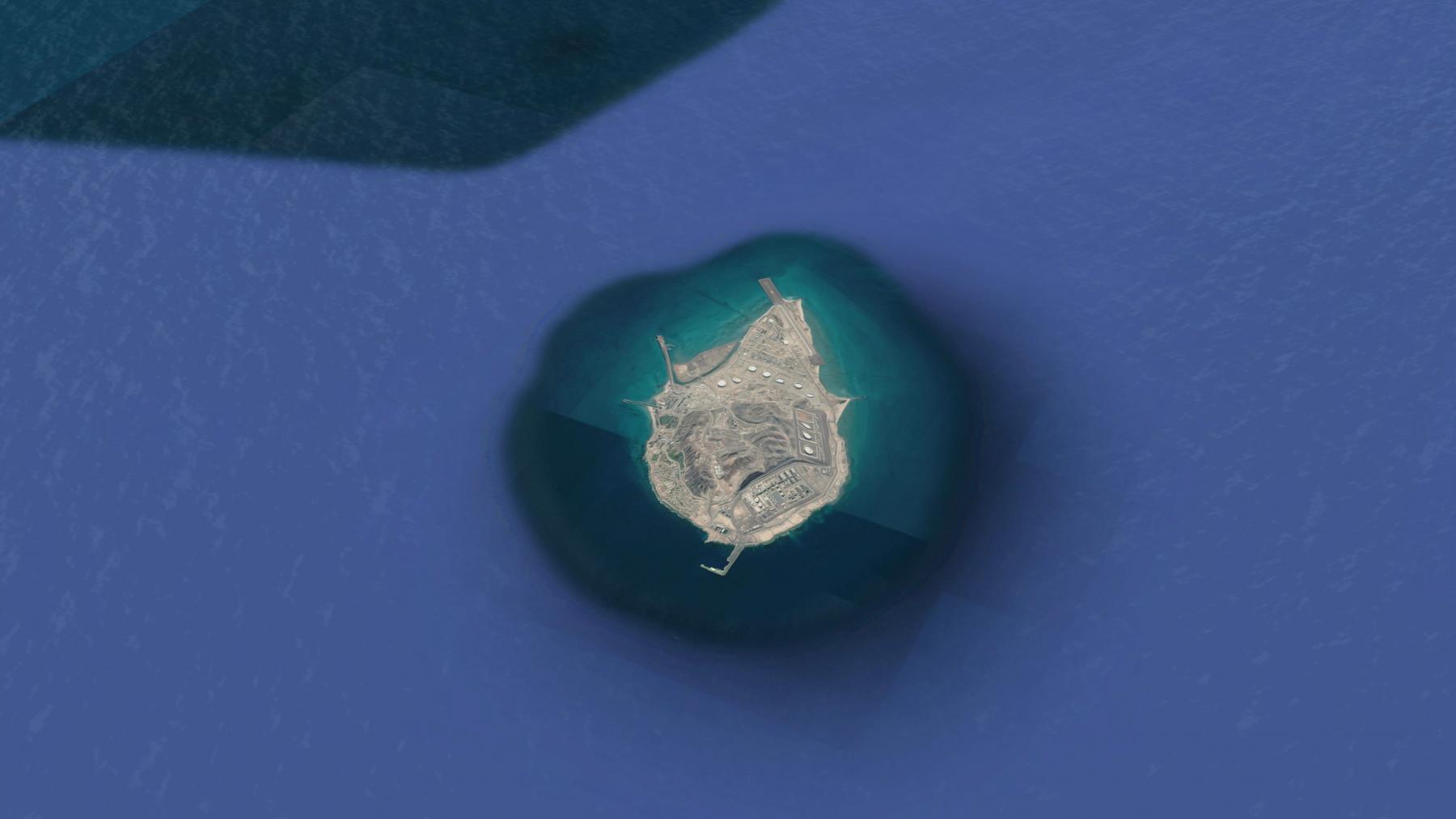
'A Stone’s Throw,' 2024, 40 mins, dir. Razan AlSalah
The conversation that follows below began in the fall of 2024, shortly after I saw Razan AlSalah’s film A Stone’s Throw at Prismatic Ground, an annual festival dedicated to expanded documentary and avant-garde film, curated and run by Inney Prakash.
AlSalah is a filmmaker and teacher based in Montreal. What I am drawn to with AlSalah’s work is her ability to pull us into an image, or have the image spatialize our cinematic experience in a way that feels tactile, immersive, moving, and expansive. Her work engages the material implications of image-making, particularly through the layering of multiple narratives and the branching pathways that gesture toward a relational movement of diasporic living. At its core, there is an anti-colonial vision—one that insists on the resurgence of life on Indigenous lands while rupturing the colonial image. Her films often operate as “ghostly trespasses,” bypassing the seemingly fortified map of colonial borders. For AlSalah, filmmaking is a form of collective memory-making, unfolding in relation with others, with place, and with the unknown.
AlSalah and I focus our conversation on one work, her most recent film, A Stone’s Throw (2024). The film follows Amine, a Palestinian elder, AlSalah’s father, who is twice exiled—first from his birthplace of Haifa to Beirut, and then again to Zirku Island in the Arab Gulf, where he labours on an offshore oil rig. Through this narrative, A Stone’s Throw moves across borders and timelines to trace the deep entanglements between oil extraction, displacement, and colonization. The film revisits the 1936 Palestinian revolt, when Haifa oil workers blew-up a BP pipeline, giving a new image to this moment of pre-1948 resistance embedded in both land and labour.
I couldn’t stop thinking about A Stone’s Throw, and I reached out to AlSalah to talk about how she’s been feeling in the context of an on-going genocide, and to reflect on what it means for her film to be circulating in a moment when genocide is being live-streamed. What are the implications of image-making today? How do images participate in liberatory modes of feeling and thinking, and how might they also trap, flatten, or erase?
In this conversation, AlSalah poses a very challenging question: how are images walls, and how are walls images?
I'm working through my limitations, which are inherently political, like my inability to return to Palestine, and how these borders are also present in the colonial image. And by rooting the filmmaking in material conditions, and limitation, we are able to reappear the ghosts and come back to the immaterial that will outlive all the violence and all the might.
Let’s talk about process – how the process led to the vision of the film. Also, I want to know how you’re feeling after winning the award at RIDM (French: Rencontres Internationales du Documentaire de Montreal). I can’t imagine this being easy that your film is circulating at this time of genocide. How has that been for you?
Palestinians living under occupation and siege in Gaza, live in different material conditions than the Palestinians in the West Bank, living under the authority of the PA1, different from the Palestinians who are refugees in Lebanon, different from Palestinians in 48.2 The colonial continuum that fragments Palestinians also does so through different systems of colonial control - there are also class differences. However, we live in the sphere of the world that feeds off of representation, that flattens these systems of colonization, in all its specificities, into a single depoliticized image: “We programmed a Palestine film at this moment, and that makes us politically relevant.” That’s why each time I am given a platform to show the film, I dedicate it to the image makers in Gaza. I’m also working with CAMP (French: Coalition des Artistes de Montréal pour la Palestine) who are working with cultural organizations in the city to build their capacity towards PACBI (Palestinian Campaign for the Academic and Cultural Boycott of Israel).
I just want to jump on what you’re saying Razan, because I actually think that the Palestinian condition inherently refuses any modes of representational practice, because it’s not even allowed in. Palestinians cannot be the voice of representation from within any kind of milieu, thinking about the university system of EDII-A, Palestinians are not allowed into this category, right? Or if we’re thinking about diversification in grant writing in the arts, right? Palestinian voices cannot be included in there otherwise you won’t receive your funds. What Palestinians are showing the world right now, besides everything else, is that we cannot enter this world, we are not part of it, and not that we want to be.
Yeah, and I think in that sense, my starting point—and ending point—is to try and think about aesthetics within a materialist framework, exactly because of that: how can I start making a film out of bare necessity, rather than through this colonial process of making - normalized by “the world”, as you say, and by the film world - which assumes unlimited resources: which scripts something—a utopia or dystopia, a story—and then extracts resources to execute an authorial vision. Resources extracted by violence and colonization - this is how the image then is weaponized to erase all the violence that produces it. This is how the image normalizes the occupation as “the world”, from Turtle Island to Palestine, from Hollywood to the zionist filmmaking industry. This is the process of representation and why we refuse it.
My process begins with: “I need to return to Palestine—how can I do it?” This is really about positioning oneself, materially, with the resistance rather than with the colonizer. Because if we think about the resistance, and how they work—yani, they have what they have, and they work with it. They use their imagination to trespass one of the most high-tech iron walls3 invented in history—with a paraglide. So I’m working with the aesthetics of limitation—I'm working through my limitations, which are inherently political, like my inability to return to Palestine, and how these borders are also present in the colonial image. And by rooting the filmmaking in material conditions, and limitation, we are able to reappear the ghosts and come back to the immaterial that will outlive all the violence and all the might.
Wow, okay—well, that actually brings me to my next question. I was really curious about the beginning of the film and wanted to ask about it, because you open with this incredible soundscape of water. Then these watercolour-like marks appear—are those animated, or is that a manipulation of the film itself? I couldn’t quite tell.
These are phytograms. Someone figured out that some plants have enough green in them—enough of a chemical that reacts with the photosensitive layer of analogue film. And that actually, with simple non-toxic materials, you can print these plants onto the photosensitive film, then develop and scan them. I was learning this new technique, and I thought—okay, maybe there’s something to collecting seaweed along the coast from Beirut to Nakoura.
I was in BC with my nephew, and my nephew is really obsessed with seaweed. We collected seaweed from the west coast of Turtle Island. I thought: this is so lovely—a fourth-generation Palestinian, Adonis, is going to every single protest, every single Saturday. We put our collected seaweed together on one film strip, and then I scanned it.
Combined with hydrophonic recordings I collected along the two coasts, we begin the film at the heart of it: the water that trespasses these different geographies and Amine’s relationship to it.
That's beautiful. You set us up in several geographies—through the material composition of the film and by way of the digitization of the map, and then through these aerial views of several locations. You're softening this eye view that's actually pretty militaristic.
You're softening it for us in a way that allows us to enter into the relation between sound and image, and the relation between the personal narrativization of history that you're presenting through your father's story, alongside these disparate but deeply connected events—the BP pipeline in Palestine in the 1930s, and the rebellion that took place there. And all of this is set against the backdrop, or refrain, of your father walking the streets of Beirut, also alongside the sea. So, I don't even know if I have a question—I'm just curious to know how you integrated all these elements into the vision of the film.
Again, I started from necessity. During the pandemic, my brother and I wanted to have conversations with our dad to understand the material conditions of his labour on Zirku Island, an island in the Arab Gulf, off the shore of Abu Dhabi, a fenced-off work camp where around 1100 male employees lived and worked 12hour+ shifts, often for extended and continuous periods of time.
Growing up, “the island” was this obscure, mystical place that our dad disappeared to—and then came back from. So we were like: where is this place? What did you do there? What kind of work? What kind of conditions?
We started recording these conversations, and at one point I told my dad, “It seems like this is going to be a film.” And he said, “No, you can’t make a film because you can’t bring a camera onto the island.” I was like, “You don’t know my work. If anything, I’m a certified expert for places where you can’t bring cameras.” [both laughing]
And so the film very much became about trying to visualize the island—studying the images as another kind of border, another wall. How these images erase the bodies of the labourers, and how that erasure can be linked to the histories of Palestinian resistance to oil and gas as projects of colonization.
I made a version for the Toronto Palestine Film Festival (TPFF), where I only used digital imaging. I showed it to Amine, and he was like, “I don’t understand this.” And I thought, okay, there’s a problem here. There’s something about this approach to studying images—it’s too materialist, too fixated on the image itself and on the border itself. It leaves no room for breath, no line of flight out of this. Where is the glitch in the image? Where is the break? How have we trespassed this wall?
This is where I realized—I really need to soften, to use your words. I actually really like that idea: that I soften. Because that’s it, right? I started listening more to Amine and what he was trying to tell me: “I remember Haifa as water. On the island, after a 12-hour shift in the sun, I would throw my body in the water.” Growing up in Beirut, I would always look at the horizon and think about what my dad would tell me about Haifa and the water, and think somehow about the horizon, like a quantum encounter, his eyes looking at the horizon from Haifa, meeting mine in Beirut.
I understood that I needed to include water, the embodiment of water. Then I realized, okay, I need to film Baba [Amine] and his repetitive walk to the supermarket and back, every single day, as his only encounter with the world. I also came to understand that picking up a camera and filming in Lebanon is, in itself, a trespass—a crossing of the colonial border into occupied Palestine. In Lebanon, as Palestinian refugees, we can’t cross the Blue Line, we can’t go south of the Litani River.
Images are walls, but walls are images, and this is the realisation that happened. Images are extensions of the border. These militarised images of the island or of Palestine inside Google Street view are extensions of the border, whether it's the border of private property or the colonial border. But then what does the resistance teach us? It teaches us that walls are also images. The reverse is also true.



The Island, still from 'A Stone’s Throw,' 2024, 40 mins, dir. Razan AlSalah
Wow. That's really profound. I've never heard that before. In your film, you break through this border-like imagery because of the way you construct an alliance between the stories of the land. Even the images in United Arab Emirates, these are all stories of what has been extracted from the land, and what those kinds of extractions condition in terms of colonial tactics, in terms of profit and then furthering that kind of land intake. I've just found it astounding that we can feel this connection that you're saying your father is feeling when he's talking about the water, that the water is this kind of connective tissue that holds these stories in affinity. As disparate as they are, they're also in total alliance, as if the land itself is speaking, and the lands are speaking to each other, through your father’s stories and your own.
Yeah. I really appreciate that, Nasrin, because this is the material/immaterial kind of connection through form. Because yes, if we think about it in terms of material conditions and how colonisation works through working the land, through resource extraction, through occupation, but then the connection that Amine makes through water is very much immaterial. It's embodied, but it's very emotional. He talks about the sensory, and there's almost like in how you framed it, there's almost like a collapse of the material and the immaterial. This is the line of encounter between the two and…
The collapse of the borders even between them.
Yes, yes, totally.
So I think that’s the resistance there too, the collapse of the borders through image.
Yeah.
This is what colonization tries to dissociate us from. I think the colonial vision is that there wouldn't be this attachment to land, but it's like you can't, that’s impossible, as long as we have our bodies and our memories, our stories, colonisation is already in itself a failure. So that's why colonisation is already in itself a failed project. Genocide is always a symptom of colonization because it attempts to sever us from our lands by way of total annihilation.
So no matter what, even in terms of what's going on in Gaza and the horror that we see take place, I actually feel like what you're talking about in terms of the senses and the memories and smelling the water, feeling the water, seeing the waters meet across geographies, these are immaterial forces that are actually material because they live in our bodies. They're cellular, they're part of our cell formation. And I’ll stop here, because there are things that I feel like I can't even explain or talk about with just anybody, and I won't talk about this with just anybody, but I'm like, you have no idea that even if we're not there in Gaza, we feel it, the steadfastness reverberates across lands and waters, no matter where we are, because we love our land, and our land is attached to us all, and we love our people, and we’re attached to them all. I wake up every day feeling the pain that reverberates across lands and oceans, much like how you describe the bodies of water meeting in your vision and memories.
Yeah, exactly.
People who are from the land are the land. And I think that right now, only art and poetry, and for me, specifically film, can convey this, and remind us of that because it's visceral, it's effective, and affective. The materiality of light, what it can or cannot capture, returns us to what we remember, and when we return to what we know, what is embodied, we're returning to our land. That's what I feel no matter how disconnected we are physically, from it. We’ll always know, we’ll always remember, and we’ll always return.
Yes. I appreciate this really. Honestly today, I feel nothing matters except the people on the ground who are fighting against this machine, this death machine. They’re fighting against “the world” as you put it.
But then what is our role? What is truly our role? As Palestinians in exile? I’m making films, so my process has to break the images and imaginaries of this world, the process of making itself needs to be a collective recollection. Yani, what you're saying is important. When I sit with Baba [Amin] and I hear him speak, it's exactly this transference that takes place as when I make this film.
When you say: what is our role? I just go back to what our parents often reminded us of: we grow up knowing our role is to never forget where we come from. So, what does that require? How do we continue to not forget? I'm not talking about just reciting historical facts or repeating our elders' stories, or that there's only one kind of way of not forgetting, as in keeping our memory sharp. Of course that will continue, but I really believe it's this process you speak of as transference. I mean, I love that you refer to it as returning to the immaterial, but to me it's material because it's so cellular. We must return to keeping that feeling activated.
I think these frameworks of material and immaterial just help us theorize, but we know that these categories aren’t dichotomous. But I think it's because today there's so much positivism on steroids, and the reduction of immaterial forces to these new age abstractions, so, there's a flattening of life on both sides. How do we reframe these relations? And I don't know, maybe material and immaterial is not the right framework. Maybe there's something about collapsing them from within. You're right, the body as land. I think of my creative process as a circle of relations—land, body, friends, family, collaborators, technology, found images, the archive, and the unknown—all coming together in a collective recollection.
I really believe that. You're right, though, they're not dichotomous. They help us understand these formations are like dreams, like dreams and dreaming. That to me is the perfect kind of example to think through how material and immaterial forces are working simultaneously.
You’ve toured this film so much now—it’s been on the circuit and it’s continuing. You just won this award. I’m wondering: what’s come up that feels new, something you hadn’t thought about before when discussing the film? And what’s been left out—something you’d like to share or emphasize more clearly?
You brought up the idea of the body as land, and I think every time I show the film, people come up to me and say they felt like they could touch the image.
Yes. It's very tactile.
In these image worlds—especially Google Earth and satellite imagery—places full of stories, histories, people, bodies, life… are captured and flattened into two-dimensional images, but are rendered perspectival to simulate spatial embodiment. You’re totally immersed but with a god-like distance. There’s something deeply colonial in that. It renders place as property, as a tourist destination, as a missile target, as something that we can command and control - from our computers far away.
That’s why it’s so interesting when people say they felt a sense of touch in the film. Because I see myself working at my computer engaging with images in tactile ways—zooming in, moving through them, using the arrow keys, making the process slow, careful and manual. This is it. I am working with digital images manually. I didn't realise that this is what I was doing until I toured with the film and so many people came to talk to me about this particular tactility.
Wow, I hadn't realised either. But that's how you bring us in. We get inside the image with you. Moving as you zoom in and zoom out. There's choreography so it’s not just us feeling you click away at a keypad. The cinematography is a form of choreography.
And of course, these images and my process itself is all incubated in the conversations I'm having with Amine, our collective history, the texts, the sounds, conversations and contributions from collaborators...they all come together in this process as a circle of relations…even Amine’s body - there’s something rhythmic about how he speaks, but also how he travels in the city, how memory accumulated in and as his body - it’s a geography in it of itself. That’s also how I realized I should pick up a camera and film.
Another thing I try to emphasize in the Q&A, which might be missing otherwise, is the history of the images I use—like the single archival image in the film, and how the colonial border extends into the archive. There’s a photobook produced by BP documenting and celebrating the labour of those who built the Haifa-Kirkuk pipeline. Yet, in BP’s archival book, the images abruptly stop at the border of Palestine, with only a single photograph depicting Palestinian labourers at the shore alongside the British military in Haifa. This absence is telling: it reveals how image infrastructures, too, operate as extensions of colonial borders, erasing those who resist them. The labourers in Palestine did not just divest their labor, they also sabotaged the pipeline, recognizing that their work was not merely economic—it was foundational to a colonial project intended to displace them.
So, I think in this case, images stand as documents, but more often they function like walls—they disappear as much as they appear. What is appeared often erases the violence of disappearance. Today, however, there’s a hyper-visibility of genocidal violence on social media, but how are these images being circulated? The distribution infrastructure depoliticizes the violence documented in these images by fragmenting us into individual users - consumers of these images. It’s sad, terrible, terrifying. Despite the visibility of the violence, we are unable to organize to stop the genocide. And so representation fails - both aesthetic and political representation has failed…
But Razan, this is why I’ve been thinking so much about your work alongside Kamal AlJafari’s and Basel Abbas and Ruanne Abou Rahme’s. It seems to me that what Palestinian filmmakers, especially those connected to the diaspora are offering is a kind of intervention that resists what you described. It’s not about a distribution infrastructure built for consumption. There’s something else at work in the making of these images—something grounded in return, in the unknown, in letting the process itself lead you to the stories that need to be told.
Yes, with Regards Palestiniens4 when we've been organizing these film screenings throughout the year, people have shared how necessary it felt to gather in a physical space, to sit with images in a cinematic, long-form way that resists the fragmented, speedy and isolated consumption of these images on social media.
I feel this process, this encounter with the archive and emergent forms are particular to the Palestinian diaspora, and I think it also goes back to us talking about what our role is.
Yes.
Our role is to keep the remembering going. I don’t have the right words for it. I don’t want to say it’s about keeping us from forgetting, because we’ll never forget. It’s a practice of continuing to remember. I’m wondering if that’s the kind of connection at play here: to glean and to save an archive of images of what has been destroyed or disappeared.
RA: The remembering always somehow happens with someone, even after they pass — I’ve heard Palestinian poetry speak to grandparents, a destroyed house, a disappeared birthplace, an image and its ghosts. I start every film with an image and a conversation… Thank you for this conversation, Nisrine! And in Arabic we say: “for putting the dots on the letters…”
What is it in Arabic?
hott ilno’at a’al hurouf
That's so beautiful.
It is.